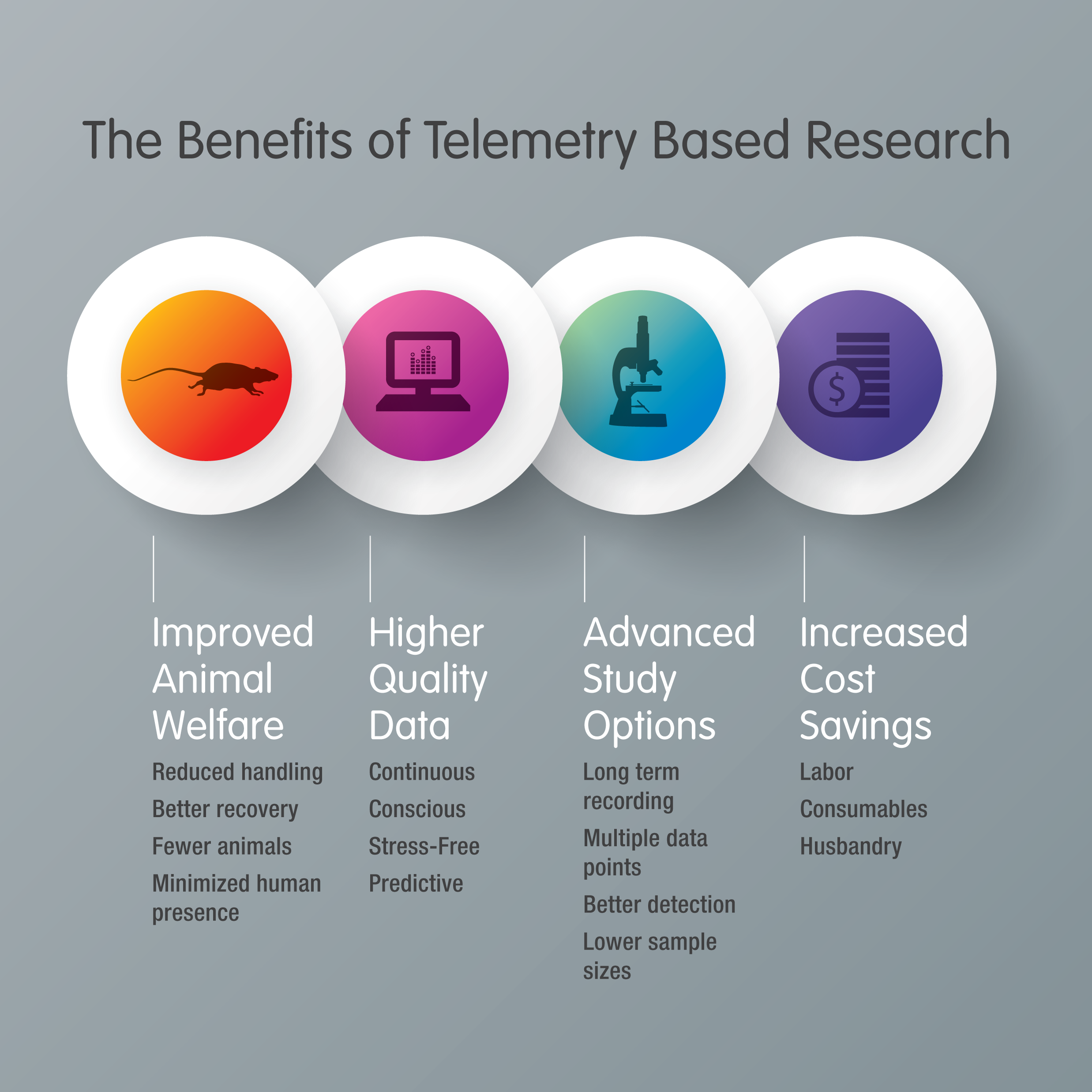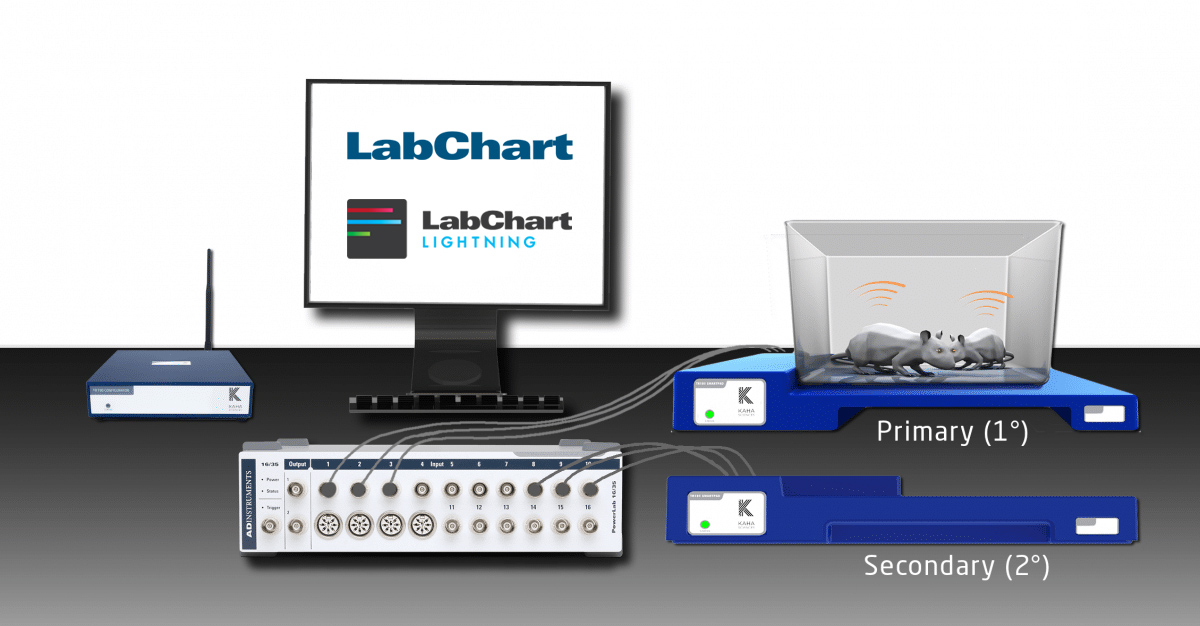What is Telemetry?
Telemetry allows the measurement of physiological signals in freely moving animals living in their home cages without the use of tethers.
The use of telemetry in animal research is a recommended industry practice for improved animal welfare. Using wireless telemetry lets researchers work with conscious, freely moving animals and reduces stress artifacts in the research data. Wireless telemetry is suitable for studies that need continuous recording for extended periods and allows the user to record multiple data points from a single subject.
Comparison of different recording methods
Four important reasons to use telemetry
1 - Improved Animal Welfare
One of the key benefits of telemetry is that it allows you to work with conscious, freely moving animals. Other data collection methods require animal restraint, which induces stress within the animal, affecting the normal physiological functions and therefore the recorded data.
Telemetry allows you to refine1 animal welfare by reducing exposure to stress and pain through:
- Reduced handling
- Fully implantable, less prone to infection
- Fewer animals required
- Minimized human presence
2 - Higher Quality Data
“It is generally acknowledged that the quality of physiological measurements collected from conscious unstressed animals is superior, since they are collected under conditions that best represent the normal state of the animal, are least influenced by chemical, stress, and psychological factors and (where appropriate) are most predictive of the results that would be achieved in human beings.” 2
- The fact that this higher quality data is collected continuously further enhances the quality of the data due to the volume of measurements and ability to minimize effects of noise.
- Anesthesia affects most physiological control systems and can significantly confound your results. Telemetry allows data to be collected from conscious animals after they have recovered from surgery, and enables cognitive and behavioral studies not possible under anesthesia.
3 - Advanced Study Options
Stress-free, continuous telemetry data enables you to perform studies and quantify data in ways not possible or feasible with other sampling methods.
- Suitable for studies requiring continuous recording over days, weeks, or months
- Ability to record multiple data points from a single subject and use animals sequentially as their own control
- Study biological rhythms and detect subtle changes that would otherwise be missed
- Animal reduction1 often occurs as a result of higher quality data and advanced study options providing the same statistical power with smaller sample sizes
4 - Cost Savings
The combination of reduced handling and smaller sample sizes leads to significant savings in labor, consumables, husbandry, and more. The reduction in labor allows for the application of labor elsewhere helping you to get more done with the same resources.

Advantages of Kaha Sciences Telemetry
Kaha Sciences systems combine high fidelity digital telemetry with patented wireless power technology to create high-quality solutions for your physiological monitoring needs. Paired with PowerLab and LabChart 8 / LabChart Lightning, this solution sets the new standard in quality and power for implantable, wireless telemetry in rats and mice.
Taking the benefits of telemetry to the next level
- A cohousing option with our rat telemeters helps to reduce the stress of single housing
- Telemeters are fully software controlled to reduce handling/impact of stress
- Patented wireless power technology allows for higher sampling rates (2 kHz), improved time resolutions, and opens the door for the unique use of more complicated and power-intensive technologies such as oxygen sensors and high quality Millar Mikro-Tip® sensors (rat pressure telemeters)
- Rat pressure telemeters incorporate a gold standard Millar Mikro-Tip® catheter containing a solid-state sensor at the catheter tip. This provides customers with the ability and confidence to measure long-term, highly accurate, and sensitive recordings from intracardiac through to intracranial pressures.
Cohousing - refinement and reduction in rat telemetry
Rats are a social species and should ideally be housed with at least one cage-mate for the duration of studies4. Some telemetry technologies require single housing, despite the recognized detrimental effects on behaviour3 and the possible impact this may have on physiological data. Solutions including the introduction of an unimplanted cage-mate and the housing of two implanted rats together with alternating recording days are not always ideal. Non-experimental cage-mates can increase the cost of experiments without directly contributing to the research outcome and alternate recording days decreases the quantity of data collected from each animal and continuity.
Our cohousing feature encompasses the important principles of refinement and reduction1, allowing simultaneous collection of continuous data from two (Fig 1.). With this feature, customers increase welfare while reducing animal use and husbandry costs.

Figure 1: Schematic diagram showing the pairing of two SmartPads to allow the cohousing feature. The primary SmartPad provides wireless power to the implanted telemeters, while each telemeter transmits data to the SmartPad paired with its respective channel.
This cohousing feature can also support implantation of two telemeters in one rat (>350g). This provides the user with the ability to customize experimental protocols and record up to four signals in unique telemeter combinations. This customizable capability has recently been published by Thakkar et al., in which our dual pressure (TRM54PP) and tissue oxygen (TR57Y) telemeters were implanted in a single rat to simultaneously record arterial blood pressure, intracranial pressure, and brain tissue oxygen to investigate hypertensive responses to stroke in rats5. This approach dramatically increases the value of each animal by reducing the number of animals required and introduces the ability to take a true “systems” approach to physiological research.
With cohousing, our customers can implement both refinement and reduction to their research activity, while also reducing time and cost. This and other unique benefits of the Kaha Sciences telemetry solutions assist our customers in pushing the boundaries of biomedical research.
Additional Resources
More about Kaha Sciences Small Animal Telemetry »
Solid-state sensors at the catheter tip - why settle for less? »
Cardiovascular Applications with Kaha Sciences Telemeters »
Five unique neuroscience applications using telemetry »
Tissue oxygen telemetry: How does it work and why is it beneficial to your research? »
Contact us to discuss your specific research application and the significant benefits our Kaha Sciences technology can have for your research and workflows.
References
1The 3Rs. http://nc3rs.org.uk/the-3rs.
2 Kramer K, Kinter LB. Evaluation and applications of radiotelemetry in small laboratory animals. Physiological Genomics 2003;13(3):197–205. doi:10.1152/physiolgenomics.00164.2002
3THE EUROPEAN PARLIAMENT AND THE COUNCIL OF THE EUROPEAN UNION,. DIRECTIVE 2010/63/EU
4Pinelli, C., Leri, F. & Turner, P. Long Term Physiologic and Behavioural Effects of Housing Density and Environmental Resource Provision for Adult Male and Female Sprague Dawley Rats. Animals 2017; 7(44). doi:10.3390/ani7060044
5Thakkar, P. et al. Hypertensive Response to Ischemic Stroke in the Normotensive Wistar Rat: Mechanisms and Therapeutic Relevance. Stroke 2019; 50: 2522–2530. doi:10.1161/STROKEAHA.119.026459